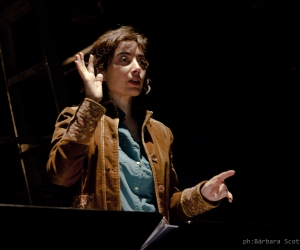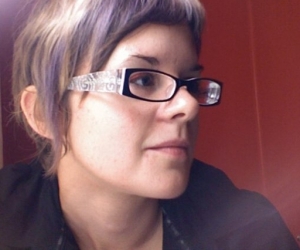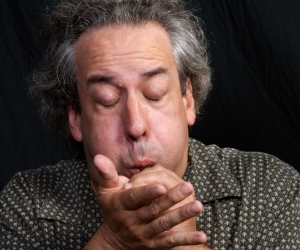
In 1961, a virtually unknown African-American band was stranded in Montreal before going on to more promising territory. During their months in Montreal they would build up a local following, mostly musicians, who could hear that something different was going on. It’s a slight and unpromising story, but the band, Sun Ra and his Solar Arkestra, never carried themselves like unknowns, never blended readily into their surroundings, and their performances at The Place on Stanley Street—performances that stretched jazz into an ancient and futurist language—would become local legend. When the band departed for New York City, seeds were left behind.
Jump ahead fifty years, and Montreal’s Ratchet Orchestra, some thirty-musicians strong—many of whom weren’t born when Sun Ra first visited their city—is in full flight at the Guelph Jazz Festival. There are strata of sound: strong melodies redolent of a procession waft upward on flutes; trombones suddenly suggest the brash conversations of Duke Ellington’s 1929 Cotton Club Orchestra; all of them stretch across a dense undergrowth of percussion and droning strings and electric guitars. Solos suddenly explode, whether from some of Canada’s best-known improvisers like Jean Derome and Lori Freedman, or perhaps the Argentine Damian Nisenson, who can contribute a mad and brilliant caterwauling on tenor saxophone. Listen even more closely and you can hear that they are the direct heirs of Sun Ra’s work, making music that stretches across time and space. Exotic scales suggest ancient Greeks cataloguing the modes of Alexander’s conquests; compound meters move with the gaps and skips of a march—a conquering army, captive peoples—across shifting terrain.
The Ratchet Orchestra is as hard to define as it is to ignore. On any given night that it plays, it is probably the liveliest and certainly the least likely band in the country, an orchestra that has existed in one form or another for twenty years, permutating from a quartet to its present numbers. It’s a vehicle for bassist–composer Nicolas Caloia’s expansive musical vision, one that takes in conflicting modes, a vast collection of disparate timbres, and a collection of musicians of different skills—some improvising freely while others read complex scores. Like Sun Ra’s band before it, Caloia’s Ratchet Orchestra is an instrument of anarchy and ecstasy, built on a mixture of discipline and liberation. Asked about the name, Caloia says, “I just liked the sound of it.” But there may be more to it—like the progressively tightening tool and its own onomatopoeic name, plus the visual echo of “Ra” at the start of the word, and sonically from that, “raw” as well.
Caloia recalls the initial impulse that led to the band’s creation: “The orchestra began when I was at school. After giving me about a year of lessons, Lisle Ellis had sent me off to study. At McGill I would organize sessions, often with as many as twenty players—sometimes we had celesta or harpsichord, oboe, and bassoon. I was fooling around with different ways to improvise, using twelve-tone matrices, intervals, or graphic scores that I dug out of the library. Malcolm Goldstein even came in and worked with us. I was playing Xenakis and Messiaen with the school ensembles, but I thought that this music would sound better if it were played with more guts; if the players had individual sounds. I imagined a different time feel, Charles Mingus and Edgard Varèse, or Severino Gazzelloni and Eric Dolphy.” You can catch all these voices in the current Ratchet Orchestra: the turbulence and drive of Mingus’ compositions; the breadth of a Varèse-like vision; the classical timbral purity of Gazzeloni’s flute; and the expressionist blasts, wails, and mutterings of Dolphy’s bass clarinet.
Both Caloia and percussionist Ken Doolittle are unsure about the dates of Ratchet’s beginnings—the band’s first album even has an image of a clock but lacks any date. Doolittle has been with the group for the most part since its inception in about 1993 or ’94. “At that time the group was a quintet,” says Doolittle. “Marlowe Börk, trumpet; Peter Buddle, tenor saxophone and electronic wind instrument; Nic [Caloia], bass; me, prepared piano soundboard and little objects; and a conga and hand drummer who remains a mystery—Nic can’t remember him.
“At that time, we focused on graphic scores—Christian Wolff, Morton Feldman, Malcolm Goldstein. I left briefly, just before the first album. Nic replaced the percussionist with a guitarist. When I joined again—after about a year—the group had changed. It was a sextet that did no graphic scores. We played pieces by Ornette Coleman, Steve Lacy, Karlheinz Stockhausen, plus original material.
“Since then, the group has been steadily growing, changing personnel, and changing its focus to the original material which Nic composes. The only other works which remain a constant part of the repertoire are those of Sun Ra. (For this reason, it seems, the standard origin story is that we started as a Sun Ra cover band.)”
Caloia employs a host of methods in ultimately pulling together a piece, “I notate a lot of the music, and then we mix it up a bit. The music is mostly written down because it saves time, but the charts are [designed] to be stretched and bent. There are sections of each piece that are improvised collectively, or else some folks are improvising freely while others are reading or improvising within tighter boundaries. I teach some of the non-readers their parts aurally. They generally play less than the schooled players who tend to get more airtime.
“From my perspective, improvisation and composition are very similar. Notating music helps the musicians to reach a consensus more quickly and gives each piece a distinct personality. It enables me to focus and direct the music’s energy before we all get together. The score gives the musicians something to escape from, or provides a frame of support for their improvisations. Including improvisation gives the band access to textures that would be extremely difficult to notate and to read. Letting the musicians play whatever they like also avails the music of each player’s full expertise and individual personality. The energy given off by improvising musicians can be more intense.”
The orchestra’s music can be heard in a remarkable series of albums, most recently Live at the Sala Rosa November 28, 2007 (self-released, packaged with feathers, and including covers of Sun Ra’s Love on a Faraway Planet and Tiny Pyramids) and the stunning Hemlock (on Drip Audio, 2012, and devoted entirely to Caloia’s compositions). Ratchet’s music is not as pointedly intense as Sun Ra’s, developing instead a sense of larger contours, with sometimes disparate materials floating in and out of the foreground and in and out of sync.
In some ways Ratchet is a history of the Montreal outré-jazz community over the past twenty years, during which it has become more expansive and more inclusive—a community coming together to embrace musicians of diverse skills and common vision, including jazz, classical, and rock players, plus new arrivals, among them violinist Jesse Zubot, guitarist Sam Shelabi, trombonist Tom Walsh, drummer John Heward, and saxophonist Christopher Cauley. Playing in the Ratchet Orchestra is a special experience for everyone in the band, each member conscious of a polyphony that goes beyond melody and rhythm to extend to Caloia’s mixed methodology and members’ different skill sets.
Clarinettist Lori Freedman says, “Ratchet is a community and Nic has totally written a book of charts with that in mind. In the orchestra there are musicians from all over the streets of Montreal, meaning a wacko-cosmos of voices!
“For me, it’s a fantasy come true, playing within a group of such diversity. More specifically though, although the improvising in this band is entirely free concerning what the material is, Nic has very closely, intuitively calculated who will blow at any given moment. He gives enormous thought to his own arrangements of his tunes. He says he has to [because], . . . you all have such strong personalities.’”
Saxophonist–flutist Jean Derome values the same dynamic and Caloia’s mixed method. “Ratchet Orchestra is a splendid project. It’s some kind of Mile-End Community Orchestra, but its roots cover a lot of ground. Some players read music, some can improvise. Nicolas doesn’t give charts to everyone. Some have a completely free role to play. These are the luckiest ones!
“When I first started to play in the band, as an invited soloist Nicolas told me just to improvise and play what I wanted. That’s how he attracted me to the group. Now I have all these difficult lines to play . . .
“The music is evolving. It started more as a joyful noise, a happening. I think that this spirit is maintained, but Nicolas’ music is evolving and maturing. Nicolas puts in a lot of energy. His writing, conducting, and group leading are excellent.
“I always like projects based on people and on the joy of playing music together and not only on the display of musical skills. When you lose this, you lose everything. For my part, I am happy to play with a mixture of professional musicians (including some of the finest players and improvisers on the Montreal scene) and non-reading musicians. I like to play in groups like this because the music, for me, is something vaster than just how good you play. I’m looking for music, hunting for music—real music; and I need some every day. Excellent players don’t always produce this.”
Caloia sees the orchestra as an essential expression of the cooperative basis of Quebec society, “The musicians in the orchestra are absolutely singular individuals, but at the same time they are open and giving and respect each other. I think that an interest in working together for a common good is very strong in Québécois culture. The deep gentle kindness and the deranged ecstatic fervour that I hear in the band come from the players. They really are like that. They have a lot of heart.”
Much of that collective identity comes from Caloia’s own force of personality, and the special force of his principal influence. Sun Ra has been important to Caloia—“I love how opposing forces exist together in his work”—since he met him in 1990 at Concordia, part of a concert and workshop produced by his friend, painter David Elliott. “I helped out a bit, then we all had supper together. At the workshop, when Sunny started singing ‘They tried to fool you, now I got to school you . . .’ it confirmed what I felt in my gut.” Describing Sun Ra’s influence, Caloia says, “He includes the bad. He is not guarded. He lets all the music come out full bore. As Picasso says, “Ah, le bon goût! Quelle horreur. Le goût est l’ennemi de la créativité.”
For trombonist Scott Thomson, a newcomer to the band, “My main focus is on my scored parts and how they link up with the rest of the ensemble’s. In sections, different kinds of improvising are prescribed—these include solos, subgroup playing, playing on changes, open ‘rave up’ blowing. But I think of these essentially the same as I do the notation, as ways to execute Nicolas’ musical goals, as best as I can figure them out. Nicolas gives us all a long tether to discover our roles within the music.
“On a practical level, there’s the unique challenge that is posed not only by the size of the ensemble, but also by its distinctively varied personnel. There are several players in the Orchestra who don’t read music at all and, as such, their role in the band is strictly to improvise. Often, in the midst of a complex notated passage with interlaced parts between the woodwinds, strings, and brass, for instance, I’ll be holding on for dear life trying to play my part properly while there’s this swirl of other, improvised activity going on around me. It’s a challenge, sure, but, when it works, it creates a special feeling within the music that is reminiscent of the Sun Ra Arkestra, an obvious exemplar for Nicolas as a bandleader, and one that is dear to my heart too.”
Veteran band member Ken Doolittle speaks of different challenges from the other side of the band. “While probably everyone in the group improvises at some time, there are relatively few who have a distinct solo presence in the arrangements. I’m legally blind, so I can’t always see the signals which the other band members can see, and have to do everything from memory. To be honest, I’m usually flying by the seat of my pants. I don’t have any jazz chops, and never really developed any traditional technical skills, like the rudiments. I can play (by ear) some complex ensemble passages by a process of muscle-memory (like the Stockhausen Tierkreis which we used to play), but Nic has given me less and less composed material as the years progress.”
Doolittle describes the special quality that has allowed Caloia to maintain and nurture the Ratchet Orchestra, “Nic has a kind of ability often ascribed to Duke Ellington and Frank Zappa. That’s an ability to put the particular talents of a given musician in a context which best highlights that talent. I think that while the music certainly presents a technical challenge to the various musicians, it is the type of challenge for which the musician is well suited.
“I think the fact that Nic gives the musicians—no matter their level of skill—a chance to sound good, is a big part of what accounts for member loyalty. From my personal perspective, how else would I have the opportunity to work with such heavy players as I do here?”
The Ratchet Orchestra has already enjoyed two decades of evolution and transformation—an eon in the life of a large improvising ensemble. It is a rare occurrence and a rare opportunity, an avant-garde ensemble that can endure, engage, and entertain both its members and its audiences. It has inspired Ken Doolittle to say, “I’m staying as long as the seat of my pants holds out.
Audio: Dusty (2009) 12:43. Composed by Nicolas Caloia. Performed by the Ratchet Orchestra: Jean Derome, piccolo, flute, and bass flute; Craig Dionne, flute; Lori Freedman, clarinet; Gordon Krieger, bass clarinet; Christopher Cauley, soprano sax; Louisa Sage, alto sax; Damian Nisenson, tenor sax; Jason Sharp, bass sax; Ellwood Epps and Philippe Battikha, trumpet; Tom Walsh and Scott Thomson, trombone; Jacques Gravel, bass trombone; Thea Pratt, Eb horn; Eric Lewis, euphonium; Noah Countability, sousaphone; Gabriel Rivest, tuba; Joshua Zubot, Guido Del Fabbro, and Brigitte Dajczer, violin; Jean René and Gen Heistek, viola; Norsola Johnson, cello; Nicolas Caloia, bass; Chris Burns, guitar; Guillaume Dostaler, piano; Ken Doolittle, percussion; Michel Bonneau, conga; Isaiah Ceccarelli and John Heward, drums. From the album Hemlock (Drip Audio). Recorded live at Hotel2Tango by Thierry Amar and David Payant, May 16–18, 2011. Licensed courtesy of Drip Audio, and Nicolas Caloia. © 2012 Drip Audio. Image: The Ratchet Orchestra on (and off) stage at Montreal's Sala Rosa. Image by: Herb Greenslade.


